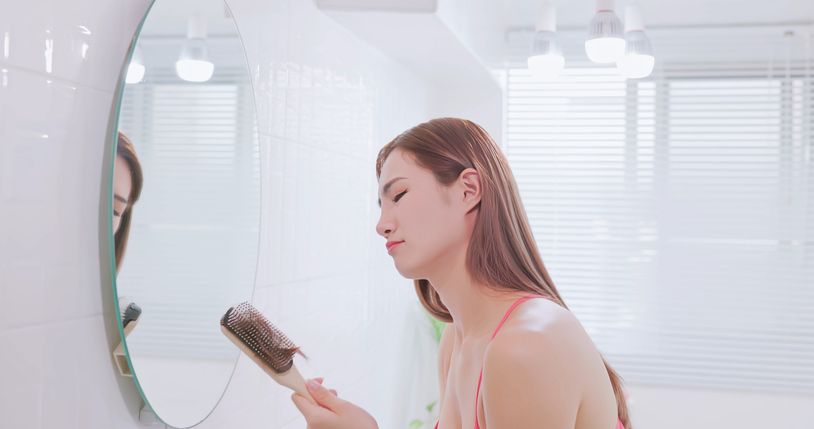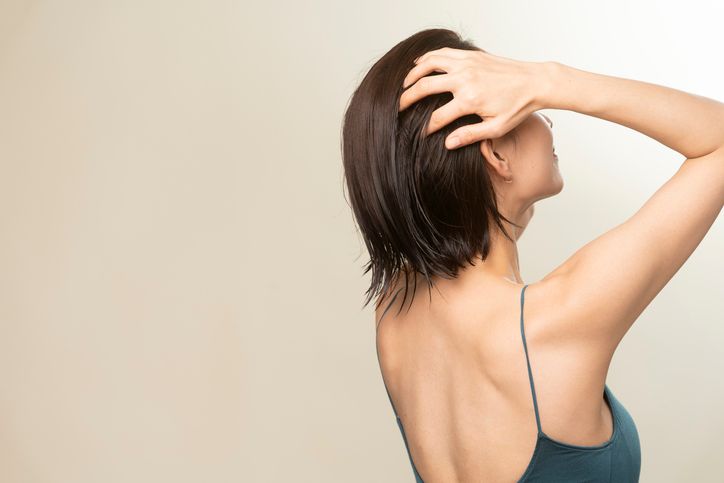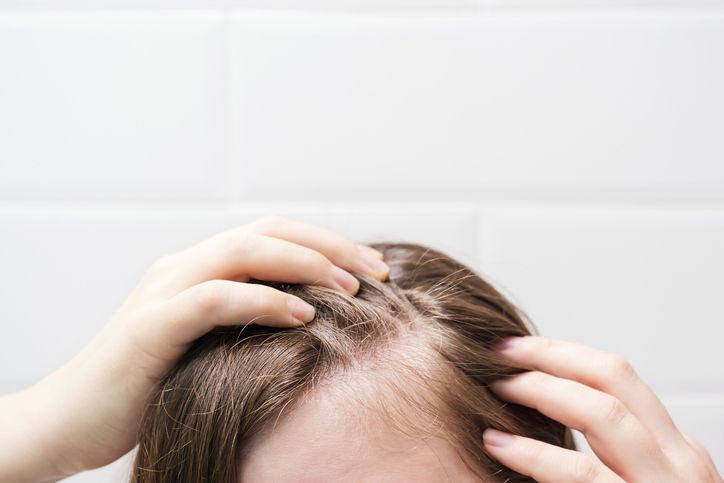- Home
- Trend
- Weight Loss Strategies
- Acne Tips
- Hair Health Information
- Blemish Removal Tips
- Acne Scar Removal Tips
- Muscle Building Techniques
- Intimate Care Tips
- Postpartum Intimate Care
- Eye Bags Wiki
- Tips for Face Slimming
- Secret of Permanent Hair Removal
- Breast Enlargement Tips
- Cure to Snoring
- Marionette Lines
- Skin-Tightening Secrets
We’ve all been there—rushing through the evening, perhaps after a late workout or a long day, and deciding to hit the bed with our hair still wet. While it may seem like a harmless habit, sleeping with wet hair can have unintended consequences for your hair health, potentially leading to hair breakage, scalp issues, and even hair loss. This comprehensive guide delves into the science behind these effects, explores the relationship between sleeping with wet hair and hair loss, and offers practical solutions, including the F8 Hair Regrowth Treatment, to help you maintain healthy, strong hair.
The Science Behind Wet Hair and Hair Structure

There are several myths and misconceptions surrounding the practice of sleeping with wet hair. Some believe that it can directly cause hair loss, while others think it’s merely an old wives’ tale. The reality lies somewhere in between—while sleeping with wet hair doesn’t directly cause hair loss, it can lead to hair damage and scalp issues that contribute to hair thinning over time.
Hair strands are most vulnerable when they are wet. The hair shaft, which consists of the cuticle (outer layer), cortex (middle layer), and medulla (inner core), swells as it absorbs water, making the hair more elastic but also more fragile. When you sleep with wet hair, the friction between your hair and your pillow can cause the cuticle to lift, leading to hair breakage and split ends.
Additionally, hair that is soaking wet or damp before bed is more prone to tangling and matting, especially if you have long hair. This can result in more hair damage as you try to detangle it in the morning. Over time, this repeated damage can contribute to thinning hair and increased hair loss.
Hair Breakage and Its Impact on Hair Health

Hair breakage occurs when the hair shaft is weakened, leading to the snapping or splitting of hair strands. Sleeping with wet hair can exacerbate this issue, as wet hair is less resilient to external stressors. The friction caused by tossing and turning during sleep, especially on rough surfaces like cotton pillowcases, can lead to significant breakage.
Breakage not only affects the length and appearance of your hair but also compromises its overall health. Hair that is prone to breakage often lacks shine, feels dry, and appears frizzy. Over time, this can create the illusion of hair thinning and can contribute to long-term hair damage.
免費體驗
F8 Hair Regrowth Treatment
1 Minute Self-Registration
Date should not be before minimal date
Scalp Concerns Associated with Sleeping with Wet Hair
Sleeping with wet hair can create a damp environment, and this is very bad for the scalp and our hair health. Here's why:
Scalp Infections and Fungal Growth
One of the most concerning risks of sleeping with wet hair is the potential for scalp infections. A damp pillowcase combined with wet hair creates the perfect environment for fungal growth and bacterial infections. Scalp conditions such as seborrheic dermatitis, dandruff, and even fungal infections like ringworm can develop or worsen when the scalp is exposed to prolonged moisture.
The warm, moist environment of a damp pillow can become a breeding ground for fungi and bacteria, leading to scalp issues that not only cause discomfort but can also impact hair health. Conditions like seborrheic dermatitis, characterised by itchy, flaky skin, can weaken the hair follicles, potentially leading to hair shedding and hair loss.
The Role of Dead Skin Cells
When you sleep with wet hair, the moisture can cause dead skin cells on your scalp to clump together, exacerbating scalp conditions like dandruff. These clumps can block hair follicles, hindering hair growth and contributing to scalp inflammation. Over time, this can create an environment that is less conducive to healthy hair growth, leading to increased hair shedding and potentially contributing to hair loss.
The Link Between Sleeping with Wet Hair and Hair Loss
The condition of your hair and scalp while you sleep can significantly influence the extent of damage and hair loss experienced:
1. The Cumulative Effects of Hair Damage
While sleeping with wet hair does not directly cause hair loss in the same way that genetic factors or medical conditions like alopecia do, the cumulative effects of hair damage can lead to noticeable thinning over time. Repeated hair breakage, weakened hair shafts, and compromised scalp health can all contribute to a gradual reduction in hair volume.
Hair loss related to wet hair is often the result of a combination of factors, including breakage, scalp infections, and inflammation. When the hair is consistently weakened by these factors, it may not grow back as thick or as strong, leading to a gradual thinning of the hair over time.
The Importance of Hair Follicles and Hair Health
Hair follicles are the structures within the scalp that produce hair. They are highly sensitive to changes in the scalp environment, including inflammation and infections caused by sleeping with wet hair. When the scalp is compromised, the hair follicles may not function optimally, leading to reduced hair growth and increased hair shedding.
Furthermore, scalp infections and conditions like seborrheic dermatitis can cause inflammation around the hair follicles, leading to a condition known as folliculitis. This inflammation can damage the hair follicles, resulting in hair loss and making it more difficult for hair to grow back.
Preventative Measures: How to Avoid Hair Damage When Sleeping with Wet Hair
To prevent hair damage when sleeping with wet hair, it's essential to incorporate effective drying techniques before bed.
Drying Techniques Before Bed
To minimise the risks associated with sleeping with wet hair, it’s actually really simple: Just dry your hair as much as possible before going to bed. Here are some effective drying techniques:
• Blow Dryer: Use a blow dryer on a low heat setting to gently dry your hair before bed. While high heat can cause damage, a low heat setting can help remove excess moisture without compromising hair health.
• Air Dry: If you prefer to air dry your hair, try to do so well before bedtime. Allow your hair to dry naturally for several hours before sleep to reduce the risk of scalp infections and hair breakage.
• Microfiber Towel: A microfiber towel is gentler on the hair than traditional cotton towels and can help absorb excess moisture without causing friction. Wrap your hair in a microfiber towel for a few minutes to remove as much water as possible.
Using Hair Products to Protect Wet Hair
Incorporating protective hair products into your bedtime routine can help safeguard your hair while you sleep:
• Leave-In Conditioner: A leave-in conditioner can help detangle hair and reduce the risk of breakage. Apply it to damp hair before bed to keep your hair smooth and manageable.
• Silk or Satin Pillowcase: Silk and satin pillowcases create less friction than cotton, reducing the likelihood of hair breakage. They also help maintain the moisture balance of your hair, preventing it from becoming too dry or too oily.
• Silk Scarf: Wrapping your hair in a silk scarf can provide an extra layer of protection, keeping your hair smooth and reducing friction while you sleep.
Scalp Care and Hygiene
Maintaining scalp hygiene is crucial for preventing infections and promoting healthy hair growth:
• Clean Pillowcases: Regularly washing your pillowcases can help prevent the buildup of dead skin cells, oils, and bacteria. This reduces the risk of scalp infections and keeps your hair follicles healthy.
• Scalp Treatments: Consider incorporating scalp treatments into your hair care routine to address any scalp issues that may arise from sleeping with wet hair. Treatments containing tea tree oil, for example, have antifungal properties that can help prevent infections.
免費體驗
F8 Hair Regrowth Treatment
1 Minute Self-Registration
Date should not be before minimal date
The F8 Hair Regrowth Treatment: A Solution for Hair Loss

For those who have already experienced hair loss or thinning due to the cumulative effects of sleeping with wet hair, the F8 Hair Regrowth Treatment offers a promising solution. This advanced laser treatment uses low-energy laser beams in combination with a specially formulated serum to stimulate blood circulation in the scalp, promote hair regrowth, and strengthen hair follicles.
• Targeting Hair Follicles: The F8 Treatment directly targets hair follicles, revitalising them and encouraging new hair growth. By improving blood flow to the scalp, the treatment ensures that hair follicles receive the necessary nutrients and oxygen to produce healthy hair.
• Combating Hair Thinning: For individuals experiencing thinning hair due to breakage or scalp issues, the F8 Treatment can help restore hair density and volume. By strengthening the hair follicles, the treatment reduces the likelihood of further hair loss.
Benefits of the F8 Hair Regrowth Treatment
The F8 Hair Regrowth Treatment offers several benefits for those dealing with hair loss related to sleeping with wet hair:
• Non-Invasive: The F8 Treatment is a non-invasive procedure that does not require surgery or lengthy recovery times. It is a safe and effective option for individuals seeking to address hair loss without the risks associated with more invasive treatments.
• Complementary to Other Hair Care Practices: The F8 Treatment can be used alongside other hair care practices, such as proper drying techniques and scalp care, to create a comprehensive approach to hair health.
• Long-Lasting Results: With regular sessions, the F8 Treatment can provide long-lasting results, helping individuals maintain healthy, thick hair over time.
Practical Tips for Protecting Your Hair While Sleeping
To ensure your hair remains protected while you sleep, starting with a hair-friendly bedtime routine can make a significant difference.
1. Creating a Hair-Friendly Bedtime Routine
Establishing a bedtime routine that prioritises hair health can help prevent damage and maintain strong, healthy hair:
• Detangle Hair Before Bed: Use a wide-toothed comb to gently detangle your hair before bed. This reduces the risk of tangling and breakage while you sleep.
• Avoid Tight Hairstyles: Tight hair ties and top knots can cause tension on the hair shaft, leading to breakage. Opt for loose hairstyles or let your hair down while you sleep.
• Use Protective Styles: If you have long hair, consider braiding it loosely before bed to prevent tangling and reduce friction.
2. Consider Your Hair Type
Different hair types may require different care when it comes to sleeping with wet hair:
• Curly Hair: Curly hair is more prone to frizz and breakage when wet. Consider using a leave-in conditioner and sleeping on a silk pillowcase to protect your curls.
• Straight Hair: Straight hair can become limp and flat when exposed to moisture overnight. Ensure your hair is as dry as possible before bed to maintain volume.
• Colour-Treated Hair: Colour-treated hair is often more fragile and prone to damage. Protect your hair by using products specifically designed for colour-treated hair and avoiding
Protecting Your Hair from the Risks of Sleeping with Wet Hair
Sleeping with wet hair may seem convenient, but the potential risks to your hair and scalp health are significant. From hair breakage and scalp infections to the cumulative effects of hair damage that can lead to hair loss, the consequences of this habit can be far-reaching. By adopting proper hair care practices, such as thoroughly drying your hair before bed, using protective products, and incorporating treatments like the F8 Hair Regrowth Treatment, you can safeguard your hair from damage and promote healthy growth.
Taking the time to care for your hair before bed not only prevents damage but also supports overall hair health, helping you wake up with hair that looks and feels its best. Whether you’re dealing with the effects of sleeping with wet hair or simply looking to maintain strong, healthy hair, the right approach to hair care can make all the difference.
Invest in your hair’s health today by adopting these preventative measures and exploring the benefits of the F8 Hair Regrowth Treatment. With the right care and attention, you can enjoy beautiful, resilient hair that stands up to the challenges of everyday life!
F8 Hair Regrowth Treatment免費體驗
F8 Hair Regrowth Treatment
1 Minute Self-Registration
Date should not be before minimal date
FAQ

1. What are the risks of sleeping with hair soaking wet?
Sleeping with hair soaking wet can potentially lead to several issues, including increased hair breakage and scalp fungal infections. When hair is extremely wet, it becomes more fragile and prone to damage from friction against the pillow. Additionally, the damp environment can create a breeding ground for fungal infections, which can exacerbate scalp conditions.
2. How can using a hair dryer help prevent damage from sleeping with wet hair?
Using a hair dryer before bed can help avoid the risks associated with sleeping with wet hair. By thoroughly drying your hair, you reduce the risk of hair breakage and minimise the chances of developing fungal infections. It's important to use a low heat setting to prevent excessive damage and ensure that your hair is not left sopping wet before going to bed.
3. Is it better to let hair air dry or use a hair dryer before bed?
It depends on your hair type and condition. For those with delicate or easily damaged hair, using a hair dryer can be more effective in ensuring that hair is thoroughly dry and less prone to breakage. However, if using a hair dryer is not an option, make sure to towel-dry your hair gently and avoid going to bed with really wet hair. Using a microfiber towel can help absorb excess moisture without being too rough on the hair.
4. How can a hair tie affect your hair if you sleep with damp hair?
Wearing a hair tie while sleeping with damp hair can cause significant damage. The hair tie can create tension and stress on the already fragile strands, leading to increased breakage and split ends. To prevent this, it's best to avoid using hair ties on wet hair and opt for a loose silk or satin scarf to reduce friction and potential damage.
5. What are some preventive measures to avoid hair damage when sleeping with wet hair?
To prevent hair damage when sleeping with wet hair, consider using a hair dryer to ensure your hair is dry before bed. Additionally, avoid going to bed with extremely rough or sopping wet hair, as this increases the risk of breakage. Opt for a silk or satin pillowcase to reduce friction and protect the hair cuticle. Finally, avoid sleeping with hair tied up tightly to prevent stress on the strands.









